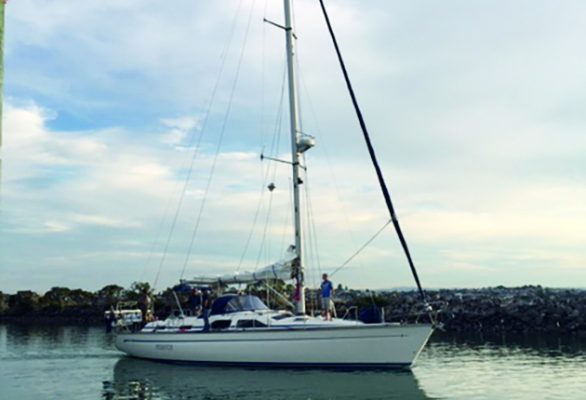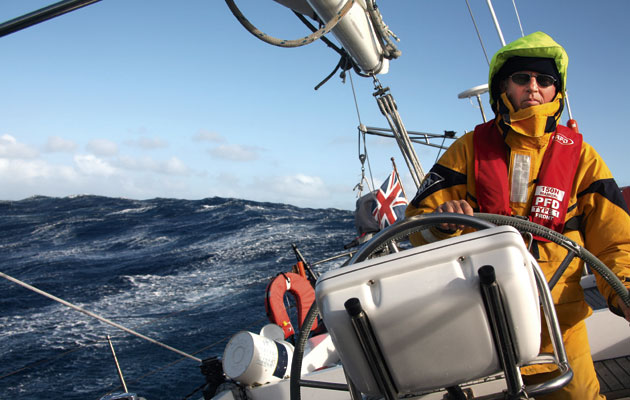An investigation by Maritime New Zealand has concluded that window storm covers could have prevented the fatal sinking of the Bavaria 47 Ocean, Essence off North Island
New regulations on window storm covers for yachts have been introduced, following an investigation into the fatal sinking of the Bavaria 47 Ocean, Essence off the coast of New Zealand.
Maritime New Zealand now requires all boats undertaking international voyages to fit storm covers on windows of more than 1853cm², and have updated the Regulations and the Yacht Inspectors’ Manual.
The story of the sinking of Essence, with the loss of the skipper, Stuart Pedersen featured in YM’s Learning Curve Sunk in a storm with no liferaft: lessons learned in our August 2021 issue.

The loss of the liferaft meant Essence‘s crew had to wait for one to be dropped by the emergency services before being rescued. Credit: Auckland Rescue Helicopter Trust
The boat was on passage from Fiji to Tauranga, New Zealand when heavy weather forced the crew to change course towards Opua in the Bay of Islands, a lee shore.
Although the four-strong experienced crew prepared for the storm, window storm covers were not fitted, despite being onboard.
Essence suffered multiple knockdowns in heavy seas before foundering in 60 knot winds off the east coast of Northland, North Island on 14 October 2019; the final knockdown resulted in the starboard windows breaking, and water flooding the saloon.

Essence’s original course, and her amended course. Credit: Maxine Heath
The liferaft was washed off the aft deck and the crew had to abandon ship into the sea before eventually being rescued by helicopter; skipper Stuart Pedersen died.
The Maritime New Zealand report into the sinking concludes that whilst there were a number of issues in relation to the sinking, ‘the key finding for the loss of Essence was the failure to have storm coverings secured in heavy seas.’
Continues below…
Sunk in a storm with no liferaft: lessons learned
Bruce Goodwin's ocean crossing with friends was nearing an end when they encountered a storm; the liferaft was lost, the…
Storm sailing: ‘The boat was slammed over and water poured in’
Randall Reeves leaves the storm jib in its bag while braving the Southern Ocean to prove that speed is safety…
Heavy weather sailing: preparing for extreme conditions
Alastair Buchan and other expert ocean cruisers explain how best to prepare when you’ve been ‘caught out’ and end up…
Adventure: guide to sailing in storms
Award-winning sailor and expedition leader Bob Shepton regularly sails some of the most storm-swept latitudes in the world. Not bad…
It also highlights the high standard of the boat and equipment and that Pedersen ‘was a highly experienced blue water yachtsman who, in the face of testing conditions, adopted a commonly-used strategy of running before heavy seas. It is clear from the evidence of the survivors that he was instrumental in contributing to the survival of his crew throughout the ordeal.’
Essence sank in the south east quadrant of the low pressure system.
‘In the southern hemisphere, mariners should avoid the south east quadrant of intense low pressure systems as more severe conditions are usually generated in this sector,’ noted Maritime New Zealand, which highlighted that the shelving coastline of a lee shore will result in more dangerous seas in heavy weather.

The late Stuart Pedersen, Essences‘s owner and skipper. Maritime New Zealand said his actions were ‘instrumental in contributing to the survival of his crew’. Credit: Jason Marra
‘If there is a possibility of encountering dangerous seas whilst closing on a lee shore, consideration should always be given to standing out to sea and heaving-to with adequate sea room to allow a low pressure system to pass before heading towards a shore,’ it added.
It also stated that liferafts should be securely fastened on deck or in the cockpit with ‘substantial through-bolted fittings’. The painter must also be secure.
Skippers are also now required to practice and demonstrate knowledge of how their boat performs with a drogue.
Read the full Maritime New Zealand report here







